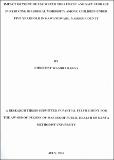| dc.description.abstract | Diarrheal diseases are one of the major causes of morbidity and mortality in developing countries particularly in children. This study took the form of a cross-sectional study to determine the impact of Point of Use (POU) water treatment and storage practices in reduction of diarrheal morbidity among a target population of children of between 0-59 months. The study setting was Kawangware sub-location, Kawangware Location, Dagoretti Sub County in Nairobi County, while the study respondents were parents of children below the age of 59 months. Three study objectives namely: Households' perception on point of use water treatment practices, households' methods of POU water treatment, as well as households' water storages practices and their impact on diarrheal morbidity among children under- five years of age were assessed. Multi-stage sampling method was utilized in the selection of the 301 children whose parents were respondents for the study. Both quantitative and qualitative method of data collection were utilized where face to face interview with parents of the children ages 0-59 months were done using questionnaires, while interview guides were used in group discussions with mothers, as well as in-depth interview guide with health facility administrator. Raw data from questionnaires was analyzed using Statistical Package for Social Sciences (SPSS) version 22, while qualitative data from group interviews with mothers was analyzed manually and summarized based on themes and patterns. The study utilized descriptive statistics as well as inferential statistics to test level of association between variables. From the study findings, it was evident that households' perception on quality of their drinking water affected uptake of PoU (p=0.839, 99% CI), and that households that treated their drinking water at point had lower incidences of diarrhea (p= -0.914, 99% CI) among children under the age of five. Additionally, a strong positive relationship (p=0. 614, 99% CI) was realized between method of PoU water treatment and diarrhea prevalence among children under five years. Lastly, a weak positive association was found between the method of water extraction from storage container and (p= -0.177, 99% CI). The researcher concludes that point of use water treatment significantly reduces diarrhea morbidly among children under the age of five years, and therefore recommends that households with children under the age of five should take up the practice. The findings will also provide requisite information to policy makers to enable them design and implement health promotion and preventive programs aimed at diarrhea reduction among under-fives. The researcher lastly suggests that further studies be carried out in households that reported treating their drinking water but also reported incidences of diarrhea among under-fives, to establish the factors contributing to water re-contamination at household level. | en_US |

